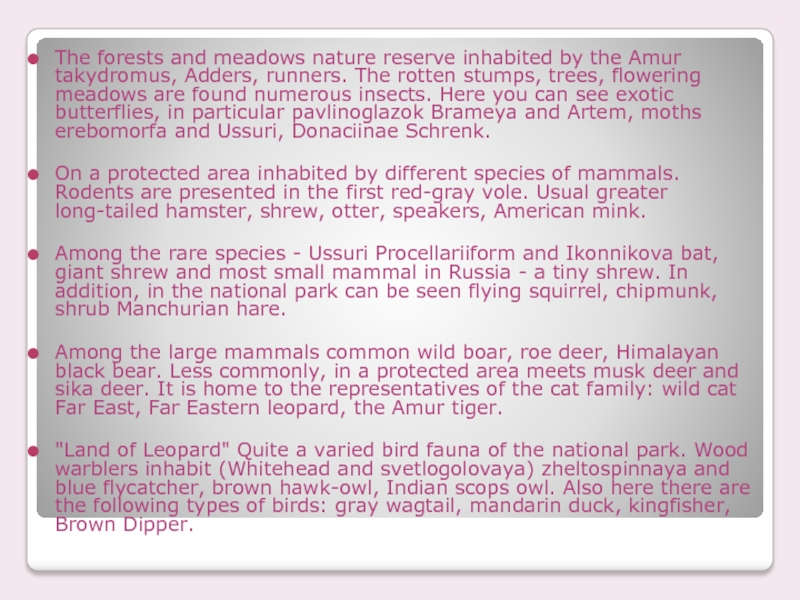Слайд 1National Park "Land of Leopard"
Слайд 2Land of the Leopard National Park was established to preserve
the natural environment in the population of the Far Eastern
leopard.
The park was established in 2012 and 5 April. Its total area - 261,868.84 hectares. By the "Land of Leopard" park area adjoining reserve "Cedar Pad".
Слайд 3The area of the leopard is already in the XIX
century, covered the northern part of Korea, the southern part
of the Sikhote-Alin and the eastern provinces of China. By the mid-twentieth century the leopard disappeared from the land of the DPRK. As for the Chinese eastern provinces, there is a leopard can be seen only near the border with the Russian Federation. In Primorye, the mid 80-ies of the last century was not a leopard on the southern Sikhote-Alin. In general, over the past 100 years, the leopard habitat has declined significantly: about 40 times. Today most of the Far Eastern leopard population is found in the south-western part of Primorsky Krai
Слайд 4National Park Land of the Leopard and its climate, hydrography
and general information
Places suitable habitat for leopards are mainly in
the area of broad-leaved and coniferous-deciduous forests, which starts on the coast and extends to a height of 800 m above sea level. Of these, the most favorable low mountains and hilly, adjacent to the shores of the Sea of Japan with lots of rocky outcrops.
In the protected area of the pools are located several rivers and large lakes – Hassan.
The park is dominated by the monsoon climate. The average annual temperature is 4 ° C. January is the coldest month, its average temperature is -15 C frost-free period lasts about 185 days.
Слайд 5National Park leopard Earth and its flora and fauna
The flora
of the park is represented by 82 species of vascular
plants, which belong to the protected and rare in the Primorsky Territory. From the total number of species is 38%. Most of the plants (46 species) is included in the Red Book of Russia.
The fauna of the National Park different species diversity. It is home to rare species of animals included in the Red Book and the Red Book of the Russian Federation.
The protected area is a permanent habitat of the Amur leopard. The local lakes and rivers is found 10 species of fish. Among amphibians widespread Far Eastern frog, common toad, Siberian salamander, oriental fire-bellied toad.
Слайд 6The forests and meadows nature reserve inhabited by the Amur
takydromus, Adders, runners. The rotten stumps, trees, flowering meadows are
found numerous insects. Here you can see exotic butterflies, in particular pavlinoglazok Brameya and Artem, moths erebomorfa and Ussuri, Donaciinae Schrenk.
On a protected area inhabited by different species of mammals. Rodents are presented in the first red-gray vole. Usual greater long-tailed hamster, shrew, otter, speakers, American mink.
Among the rare species - Ussuri Procellariiform and Ikonnikova bat, giant shrew and most small mammal in Russia - a tiny shrew. In addition, in the national park can be seen flying squirrel, chipmunk, shrub Manchurian hare.
Among the large mammals common wild boar, roe deer, Himalayan black bear. Less commonly, in a protected area meets musk deer and sika deer. It is home to the representatives of the cat family: wild cat Far East, Far Eastern leopard, the Amur tiger.
"Land of Leopard" Quite a varied bird fauna of the national park. Wood warblers inhabit (Whitehead and svetlogolovaya) zheltospinnaya and blue flycatcher, brown hawk-owl, Indian scops owl. Also here there are the following types of birds: gray wagtail, mandarin duck, kingfisher, Brown Dipper.

Слайд 7National Park leopard Earth and its attractions
By the way, today
anyone can observe the life of leopards in the wild:
the park is a unique series of shooting these animals.
Its creators promise to show the audience something amazing, something not seen even by those who studied the leopard throughout his life. The series will show the real life of a large family of leopards without special effects and embellishments. To date, the series came five series, which can be seen on the official website of the National Park "Land of Leopard"
Слайд 8The Far Eastern leopard
This is the least few and almost
the smallest, but the most hardy predator spotted subspecies of
the nine existing ones, which paid close attention to the area of environmental complex "Land of Leopard". National Park has all the conditions for successful reproduction in population.
He has excellent vision: a distance of 1.5 km of the beast is able to see their prey, so he prefers to populate the steep ridges, which also help him to avoid meeting with the tiger - its natural enemy. It is an excellent climber, runner, swimmer and diver. From the place Amur leopard can jump to a height of five meters. This result he achieves because of its long tail, which also serves as a balancer during maneuvers and descent of a steep slope. The Far Eastern leopard is able to drag production exceeding its own weight in 2 times.
Слайд 9Leopard trail
This ecological path length of 1680 meters operating since
2006.
The trail, elevation changes which are 100 meters, is equipped
with observation decks, parking for recreation, information boards and bridges through the picturesque Glens. The route crosses the areas of broad-leaved forests of cedar plantings of different ages and rare plants, and also passes through the fern forest. These zones provide a clear understanding of "home" Leopard.
Слайд 10 From this information it can be concluded that
the plot of land on which there is a National
Park, it is an amazing and unique, to which people have to take good care of, thus preserves the population of the animal and plant worlds.
For the sake of curiosity and extreme sensations can visit this place and remember this day for the rest of life.